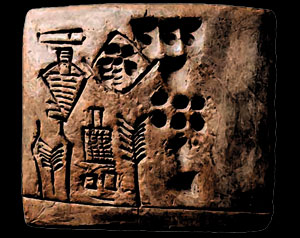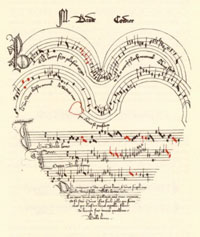
From Cuneiform to Text Messaging

Figure 1: A Babylonian tablet inscribed
with the directions forbrewing beer
(c. 3100 BCE)
Is there a difference between the digital emoticons of a text message today and the ancient pictographic script of 3,200 BCE? What can the study of “visible language” (i.e., writing and signing, as well as notated forms of music and dance) tell us about construing and sharing meanings, and, ultimately, of understanding ourselves in relation to the world?
Since the origins of writing, many uses of language and other forms of symbolic expression have developed that allow communication among people who are not co-present in time or space. Concrete visible texts make it possible to review, to analyze, to revise, and to recontextualize language use. This has led some scholars, such as Walter Ong, to argue that writing and literacy have begotten nothing less than a transformation of human consciousness. However, we take issue with the notion of a “great divide” between so-called “oral” and “literate” societies. In the case of cuneiform text—and instant messaging and Web 2.0 applications today— trying to look at language use in terms of oral/literate dichotomies only obscures our understanding. Cultures of orality and literacy are so intertwined that we have to consider them together rather than separately.
Other scholars (e.g., Ignace Gelb) have construed a linear, evolutionary history of writing that moves from pictographic, to logographic, to syllabographic, finally coming to its own in the alphabet. Although such a scheme is attractive at first sight, its flaws become apparent when one realizes that mixed syllabographic/ logographic systems are still with us (in China, for instance) and that, arguably, text messaging and other newer forms of communication have re-introduced aspects of logographic and syllabographic writing.
It seems better, therefore, to abandon all-too-general teleological and deterministic theories and to understand writing as a fundamentally historical phenomenon, bound by the technology of its medium on the one hand and by social context on the other hand.
Cuneiform writing, the first writing system to be developed, was simple from a technological point of view. All one needed was some refined clay of the right consistency and a reed pen. Clay and reeds were both abundantly available in the southern area of what is now Iraq. The longevity of cuneiform, which was used for more than three millennia (from about 3,200 BCE to 100 AD), may in part be ascribed to its unassuming medium and its low costs. The other side of the coin is that clay is bulky and heavy and may be inscribed only for a certain period of time. Once the clay has dried out it becomes difficult to add more text—in practice a clay tablet cannot contain more than what one can write in a single day. Cuneiform was used primarily for administrative purposes, but the idea of a ledger, where one adds new items every day, was simply not within the realm of the possible. Instead, daily transactions were written on small tablets that were collected in a tablet basket. At the end of the accounting period the entire basket was summarized on a beautifully written multi-column tablet, which incorporated the information of each daily tablet and provided the totals at the end.

Email is the opposite of cuneiform in many respects. It is not bulky, and has no weight, but it requires a very complex technological infrastructure to work. Like clay tablets, however, it does not work well with a text that grows over time. The same is true for texting—but that hasn’t prevented Japanese authors from composing entire novels on their cell phones. The point is that technological restrictions are usually not decisive if there is a societal need or impetus strong enough to make people find a way around them.
Writing in its various forms is a social activity that is bound by social norms and follows strict conventions. The importance of conventions is hard to overestimate. Spelling, layout, headings, indexes and captions are all bound to conventions that facilitate understanding. Grammatical norms from written texts are very different from those in oral communication. Because every form of writing (and its technological means of production) has limitations, people develop conventions and specific writing styles to cope with those limitations. Developments in email and texting have made us aware that such conventions may develop differently; not only from one medium to another but also from one purpose and context to another within the same medium.
Historically, the relation between written and spoken language is a complex one. Writing was not invented to reproduce spoken messages. The earliest written texts represent transactions rather than sentences. A beer account, for instance, lists the amounts of raw materials (primarily grains) delivered, the amount of beer expected and the name of the person responsible (Figure 1). The layout of the clay tablet in different columns (and with totals on the back) represents the syntax of the transaction. We assume that the words for beer and grain were those in use at the time in whatever language these ancient people spoke, but the words do not add up to a grammatically sound sentence. The structure of the earliest writing system may be compared to a modern software package that uses words from the colloquial language (in menus or field names) but does not mirror in any way the common use of such words in proper sentences.

Figure 2: Baude Cordier’s rondeau
“Belle, Bonne, Sage”
Early writing developed as a response to a rapid increase in the complexity of society and as a means to control goods and information. The incapability of early writing to capture full sentences was not a flaw in the system, but rather a result of the societal need that brought writing into existence in the first place. Over the centuries the cuneiform writing system developed in ways that did make it possible to represent full grammatical sentences in various ancient languages. By the beginning of the second millennium BCE cuneiform writing was used for a wide variety of purposes, from poetry to personal letters and from administrative notes to medical handbooks. The basic technology of clay and reed had not changed, but an entire infrastructure of schools and school texts had been set up to educate new generations of scribes and to respond to the renewed demand for writing. More recent developments in writing suggest that the development of new conventions may be first driven by the peculiarities of the medium (such as the keys of a cell phone or the number of characters the screen can display) but are then solidified by the social cohesion and identity that they provide in the form of a shared code. We see this in the case of spelling: in the early days of printing, letters were added or subtracted as needed in order to maintain an even line length. Many of these “modified” spellings then became codified through dictionaries. In the early days of email, when only ASCII characters could be used, people whose languages did not use the Latin alphabet wrote email in “romanized” script. However, even after Unicode became well established, allowing people to write in their native script, many chose to continue to write in romanized form, which had become natural and customary for email. In music, the notational techniques explained in Philippe de Vitry’s treatise Ars nova (c. 1322), which included the use of color, made it possible to notate things people had never thought about notating before; this gave rise to melodies of unprecedented complexity (ars subtilior). A famous example is the heart shaped manuscript by Baude Cordier (Figure 2), which uses the notation to iconic effect.
Visible language is therefore about cultural practices that arise from the interaction of social environment and technical affordances of media. While technologies of writing, from cuneiform clay tablets to electronic media, are fundamentally different, the underlying human processes of adapting forms and functions to various technologies of writing and to the social needs of the time are nevertheless similar. The juxtaposition of different media from different periods in the history of writing brings new insights to light, both in terms of the technical aspects and the social practices associated with writing.
Rick Kern (French) and Niek Veldhuis (Near Eastern Studies) are the co-conveners of the Townsend Center Visible Languages faculty research group. Brought together by the Townsend Center's Project on Disciplinary Innovation, more commonly known as "Course Threads," the group met once a month during the spring 2009 semester to discuss forms of visible language. Faculty participants were Sarah Freedman (Education), Jerrold Cooper (Near Eastern Studies), Gary Holland (Linguistics), and Davitt Moroney (Music).
This article can be found in the September/October 2009 newsletter.